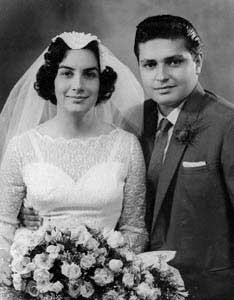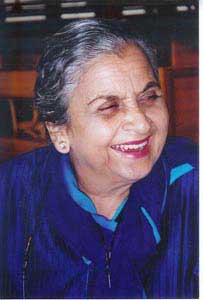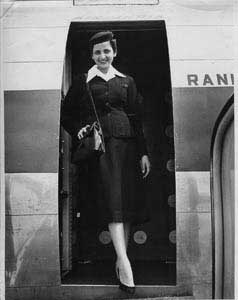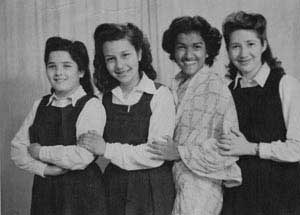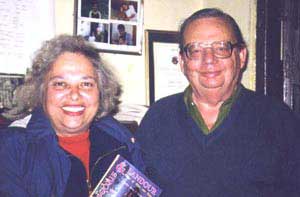Arts
Beyond The Pale

Anglo Indians are perhaps the first and largest experiment in East-West genetics.
|
Joyce Mitchell recalls growing up in a railway colony in Ratlam, in pre-Independence India, cocooned in a seemingly idyllic and insulated world, attending a European Anglo Indian Railway school. A visit to Bombay for higher studies introduced Mitchell to her first “Indian” friend, a Hindu girl, 12, whose father, an Indian Navy commander, almost got court-martialed, because he hoisted the Indian flag a bit too soon on the day of India’s independence, which was still under the British regime – for a few more hours anyway.
For Mitchell, Mrs. Kirby, a fair skinned Anglo Indian married to a British man visiting India, held the keys to the promised land. “Mrs. Kirby would say, ‘Ah, the fish mongers, the fish lying on marble slabs!’ Sitting there wide-eyed I would think, as an Indian I’m never going to get to heaven. But the closest I could get to it was if I could get to England!” Mitchell, then 18, was chosen as a companion for Mrs. Kirby’s daughter and the Kirbys, who were returning to England, encouraged her parents to send her with them. Since her parents couldn’t afford the fare, a kindly uncle chipped in to enable her to travel, as she recalls, “on the oldest ship that ever sailed the Indian sea.” England was cold and unwelcoming. “I stood there in strange tweed clothes, a hat and garters, clutching two leather suitcases waiting for someone to carry my bags, till a porter told me I had to do it myself. Mrs. Kirby, whose family was never accepted as British, but remained the inferior country cousins, was relegated to cooking the most horrible food for us, something she never did in India, and I wondered what was I thinking wanting to come here?”
Mitchell’s dilemma was shared by hundreds of thousands of Anglo Indians after Independence. Although the phrase Anglo Indian was initially concocted to describe Englishmen who returned from their stay in India during the British Raj, by the 20th century it had taken on a new spin. It now describes the 500,000 strong community spawned from the 17th century onwards as a result of unions between European colonists and Indian women. Prominent Indians many, even celebrities: media commentator Melville DeMellow, author Ruskin Bond, cricketer Roger Binny, actresses Vivian Leigh and Merle Oberon, hockey star Leslie Claudius, tennis ace Leander Paes, former Ms World Diana Hayden, world billiards champion Wilson Jones, quiz master Derek O’Brien, among others. Anglo Indians prided themselves as British. But the British shunned them, because they weren’t purebreds. Before Independence, the community was given some leeway for the Englishness of their bloodline through reserved government jobs in the Railways, Posts and Telegraphs, Customs and Police. The top brass was always British; the Anglo Indians managed to net most of the supervisory posts. The privileged world of Anglo Indians, however, came crashing down with Independence. Some, like Mitchell, who had the opportunity, migrated to England or other parts of the commonwealth or the United States after Indian independence. They were in for a rude shock – social outcasts in the promised land. Mitchell went on to study and work in England. When she returned, her parents were aghast at her new English accent. “They were still the same, it was I who had changed. But in a strange way I went to Britain and rediscovered my Indianness,” says Mitchell, who worked as an Air India hostess before marrying and settling in the United States. Blair Williams, who worked for the Indian Railways, before migrating to the United States, says in his first 17-18 years as an Anglo Indian he did not have the remotest idea about India, Indian culture, or other Indian communities. He attended Anglo Indian schools, an Anglo Indian college and lived in areas where he was surrounded by Anglo Indians. “I lived in a fairly isolated, almost lopsided, distorted world,” recalls Williams.
After he passed the Civil Services Exam and joined the Indian Railways he was in for a rude shock. “There were no Anglo Indians in the civil services. I can’t tell you how mercilessly I was ragged. I had a terrible accent. I couldn’t speak the Indian language and made many linguistic blunders. Every one kept ribbing me. Fortunately I was good at sports, otherwise I would have had no redeeming quality in the eyes of the Indians working with me! They also thought I could handle labor. Things were very tough during the early 70s with the Naxalite movement at its height, and they even killed my foreman, but I managed to do well and win the loyalty of my men.” Four years later, Williams was a transformed man. “I was totally immersed in the Indian culture, my best friends were Indians. For the next 15 years on the railways I mixed only with Indian officers.” Blair’s wife Ellen comes from British and royal Muslim lineage, something that, she says, “was authenticated when the Queen visited us.” Her grandfather was an accomplished Urdu poet. “I can speak fluent Urdu, and never thought of myself as anything but Indian,” says Ellen Williams. Authors Sylvia Staub and Margaret Deefholts, who also grew up in the cocooned Anglo Indian world, say they have retained a deep sentimental attachment to India. Growing up in India was idyllic and they wouldn’t exchange those memories for anything in the world. Deefholts says after independence she heard occasional subdued rumbles insinuating that the British have left, so why don’t Anglo Indians go home as well. “Now when I look back, there were comments like, ‘Why don’t you get out of India? You are not Indian, You don’t speak the language, you don’t know much about Indian culture.’ But home for us was India.” Ron Forbes, president & CEO of Juvenile Diabetes Research Foundation in Canada, who was born in Calcutta says Anglo Indians at the time shared the lifestyle of affluent Indians. “We spoke English, went to theater and classical music concerts. So what we shared was really an international culture and not Indian or British as such.”
Forbes says while he does not like to label his identity as Indian or Anglo Indian, he relates more comfortably with Indians and sees himself as Indian. Forbes left for England, armed with an MBA degree, rose rapidly in banking and lived in England for 20 years before moving to Canada. He says the British in England behaved very differently from the British in India. “The British in India would go to the clubs and dance and party every evening. In England they barely managed to go out once a month.” Forbes says he always said he was Indian when asked in England. He would then be peppered with such questions as: “Why is your name Forbes? Why do you speak English in that accent, which is unlike any other Indian accent?” He says he never witnessed any nostalgia for India among Anglo Indians he met in Britain, nor any particular consideration from the British. The Anglo Indians were trying their hardest to assimilate and more concerned with making it than touting their Anglo Indianness to the British. It was the same with Anglo Indians who chose to remain in India. After independence, the British quit India and Pakistan, leaving behind their country cousins at the mercy of the local governments. Many Anglo Indians panicked and migrated to England, Australia, Canada, and United States after 1950 to seek a better life. Some chose to stay back in India and Pakistan.
Life in Calcutta was idyllic for the large Anglo Indian community, and Indians from the upper crust of society attended school and college with Lumb and socialized with him regularly. Marriages outside the community were frowned upon, says Lumb, who became a journalist and married an Anglo Indian in 1963. At the time several Anglo Indians were doing well in mercantile houses, customs and other areas and Anglo Indian women were always in great demand for nursing, teaching, secretarial and executive assistant posts. The men, he says, had a harder time after independence, because reserved positions no longer existed and many of them had not pursued higher studies, even though they graduated from St. Xavier’s, which is still ranked among the leading high schools in India. The top jobs went to well educated, well connected Indians, while Anglo Indian men often ended up with clerical or junior management assignments. “Several Anglo Indian men started migrating to Canada and later to Australia, although color played a part in how the Anglo Indians were treated both in India and abroad,” says Lumb. “My fair skinned cousins were allowed to swim in the Calcutta swimming club that had a ‘Whites Only’ policy. I could not go in, because I’m brown skinned. Australia opened its doors to immigrants from all over the world, waiving its ‘Whites Only’ policy in 1967. Before that quite a few Anglo Indians, including my aunt and her family, went to Australia, at a time when only white skinned Anglo Indians were allowed to immigrate.” Lumb says although he was doing well in Calcutta, he began to have concerns for his son’s future in India. “I knew the Anglo Indians had started doing well abroad. In Australia, for instance, the Anglo Indians spoke better English than many other immigrants and had western habits, so they didn’t find it hard getting work.” Lumb migrated to England because of his journalistic background and dreams of working on Fleet Street. He joined Reuters and later the BBC. But at a personal level, he says, the migration to England was a terrible disappointment.
“We just loved the warmth and hospitality and the sweetness of India. To end up in this cold damp country where you never got past talking to people over a garden fence or the front door was tough to get used to. Our neighbor once told my wife we had more friends and relatives visit us in the one year we had been there than she had in the 15 years that she had been living there. I called the front parlor of most English homes the mausoleum or the funeral parlor. It was well furnished and immaculately kept, but there were never any visitors to enjoy it. It was a hard transition from the joyous and cheery, social interactions in India to becoming part of a community that was in the habit of turning inward socially and living within its own self imposed walls.” Lumb and his family moved to Canada in 1973 after racism reared its ugly head. The Tory MP Enoch Powell’s anti immigrant speech blaming immigrants for the ills of British society was the last straw, and soon after Lumb moved, race riots rocked Britain. “I know of several Anglo Indian families who moved to Britain first and shared my disappointment with it. We felt, who wants to be in an old country with old ways that still doesn’t understand that the days of the empire and white supremacy have ended.” Canada, by contrast, was a charm. “For all its cold weather Canada is an exceedingly warm hearted country. Our three children blossomed and had a much better social life here. They also learnt to be confident and proud of their brown skins. They had been heckled in England.” Sylvia Staub says she regrets that the Anglo Indians were caught in the crosshairs between the British and India. “I am very sentimental about India. The British were snobs who looked down upon us and because we as a community were dependent on the Brits for our daily living we ended up having very little to do with the Indians. I blame the British for the great divisions they created between the Indians and the Anglo Indians, something I have always regretted.”
After moving to England, Sylvia first worked for the Indian High Commission in London before moving to the United States. She retained her Indian passport and says she has always been proud of her Indian heritage. Margaret Deefholts says her extended family moved to Canada to be together and because she felt her kids had a better chance of eking out a living abroad. They didn’t migrate to England, because she never felt England was home. “I speak only for myself, but I think the British in India were insufferable and I had no respect for them.” Many Anglo Indians, now in their 50s and 60s are trying to return to their roots, to shatter myths and negative stereotypes about the community that have taken root in history and to coax the younger generation into preserving their heritage. Blair Williams has founded CTR, a non profit organization that supports needy Anglo Indians in India. He says that post independence history is littered with biased writings by Europeans and Indian authors about Anglo Indians. Academic literature has also failed to record the contribution and sense of community among Anglo Indians and there is no literature on the community by Anglo Indians themselves. “I realized that if we did not do anything to rectify this, then history will continue to remember the Anglo Indians in a lop-sided way,” says Williams. “The women would be perceived as less ethnic and more sexually promiscuous than Indian women, and the men as alcoholic wastrels who did nothing except party.”
Sylvia Staub says most Anglo Indian women lived a very protected life. When she went to England to work for the Indian High Commission, a Bengali woman had to take her under her wing because of her naiveté and show her the ropes. Margaret Deefholts and Joyce Mitchell, who were brought up to be self confident, say there were widespread false presumptions about the promiscuity of Anglo Indian women. “There are promiscuous women in every culture,” says Staub. “Just because Anglo Indian women were more outgoing and fun loving, and worked, unlike many of their Indian counterparts, didn’t mean they were of loose character.” Adds Deefholts, “But that kind of gossipy look at the Anglo Indians was what made for a juicy story! On a serious note I think Anglo Indian girls were very beautiful and dated and went out. In that particular era that was regarded as not genteel by Indians. Today the Indian women have changed so much and become even more liberal and no one bats an eye.” Anglo Indian men also had to overcome the false rap of being alcoholic party animals. The community has understood the importance of education and many Anglo Indian men are now thriving, assimilating into the Indian mainstream and excelling in diverse fields. “Even in those days my little town of 80,000 had international hockey players, an Anglo Indian woman had been to Wimbledon, among other things,” says Sylvia. There is renewed interest among Anglo Indians, especially those living abroad, in its heritage. Williams recently published an anthology of Anglo Indian writing titled, Voices on the Verandah. Several websites on the community have mushroomed. “These days when people ask about the community, I don’t waste my breath,” says Lionel Lumb. “I just say go the internet and read up.”
Within the United States, Anglo Indians hold reunions, where they revel in eating Indian curries and reminiscing on the linguistic jargon they had grown up speaking. There is even an annual international Anglo Indian Reunion held in different parts of the world. Megan Mills, a Canadian, who wrote her PhD dissertation on “Ethnic Myth and Ethnic Survival: The Case of India’s Anglo-Indians (Eurasian) Minority,” says while interviewing a broad cross section of Anglo Indians worldwide, she frequently heard fears about the extinction of community. But the community has survived for over 400 years. Younger Anglo Indians, she says, often tire of their parents’ nostalgic memories. But most youngsters do. “Yes, the young are different. What else is new? But most communities do not tend to adhere as closely to the way of life brought from India through generations!” “If the same young people abroad are told ‘Here’s a deserving family in your family’s old town that could use a few bucks and someone to write to the kiddies, or whatever else you can think of,’ it will be a different,” says Mills. She also emphasizes that the reality is that everyone is marginal to everyone else in South Asia. “If one speaks to Indians old enough to remember 1971, or the border wars, one finds they know an awful lot about Anglo Indians from every walk of life who contributed, in various ways.”
Mills adds that she has come across cliques even within Anglo Indians, a fact confirmed by several Anglo Indians, but it seems the value system is remarkably similar across backgrounds and classes. Anglo Indians have very strong family ties, they are usually liked by others around them, and again, seen as part of the social wallpaper, says Mills, and not as the “freaks” or romantic castaways, or dinosaurs projected by journalists or writers. Lumb says he wants history to remember the Anglo Indian legacy as that of a people who contributed in large measure to the success of the British empire, but did not, at the same time lose their close attachment to India. “We were born there and love to go back. As little children we were told some English tales at bedtime by our parents, but then came our ayah, who told us lovely Indian stories and somewhere the lines blurred. There isn’t a single Anglo Indian who grew up in that era who doesn’t get confused at some time or the other and wonder, ‘Was that the English story or was that the Indian story?’ When I see an Indian sunset, whether it is on the beaches of Goa or in the mountains of Kulu valley, I know that this is my spiritual home, no matter where I live.” Staub muses, “Our history is important because we have been the largest, most interesting experiment in genetics between the east and the west and have represented the finest of both hemispheres in many ways. We even learnt values like loyalty from the British, who preached, but never practiced it. From our Indian brethren we learnt kindness, hospitality and a wide open attitude towards religion, because Hinduism is a philosophy, a way of life and open to any one who cares to be a part of it. We are also the only truly global community and there is a lot the current generations can learn from us.” |


